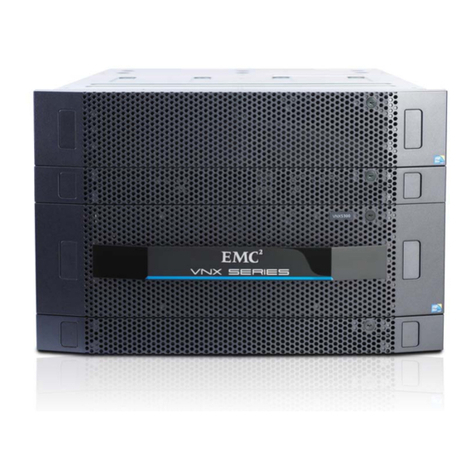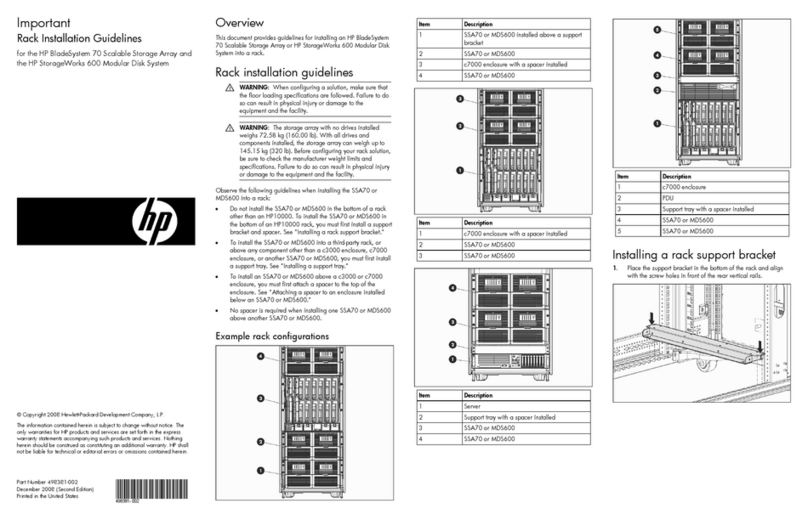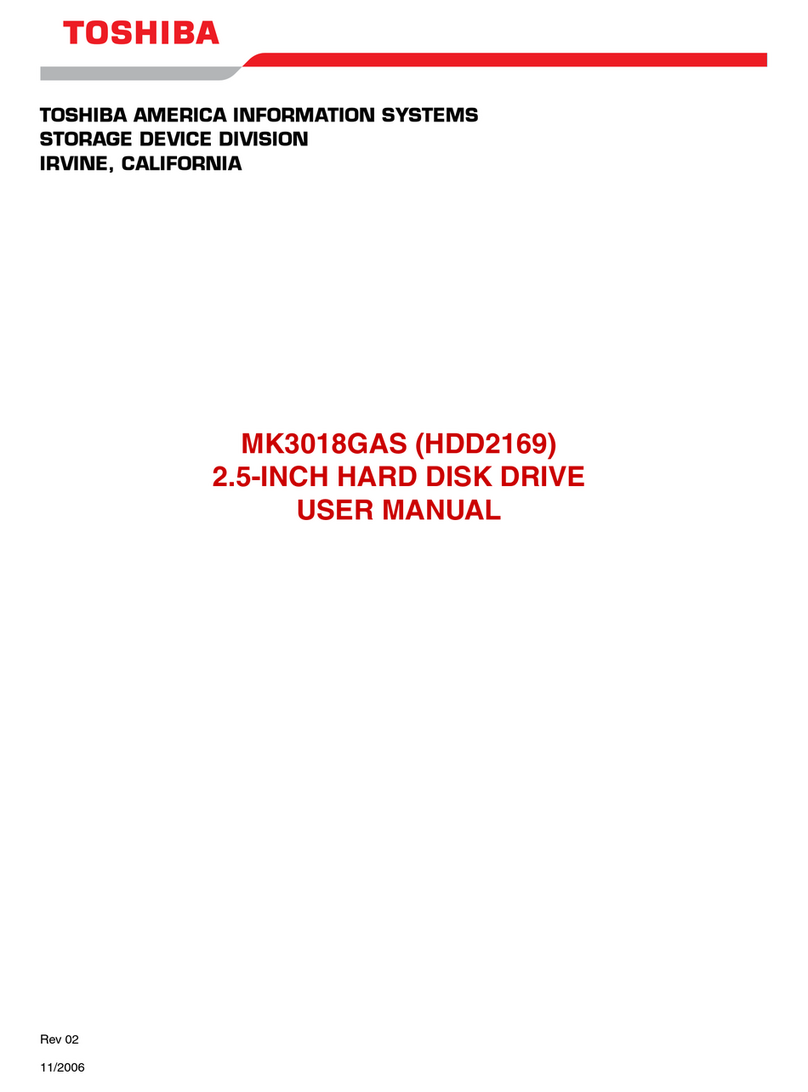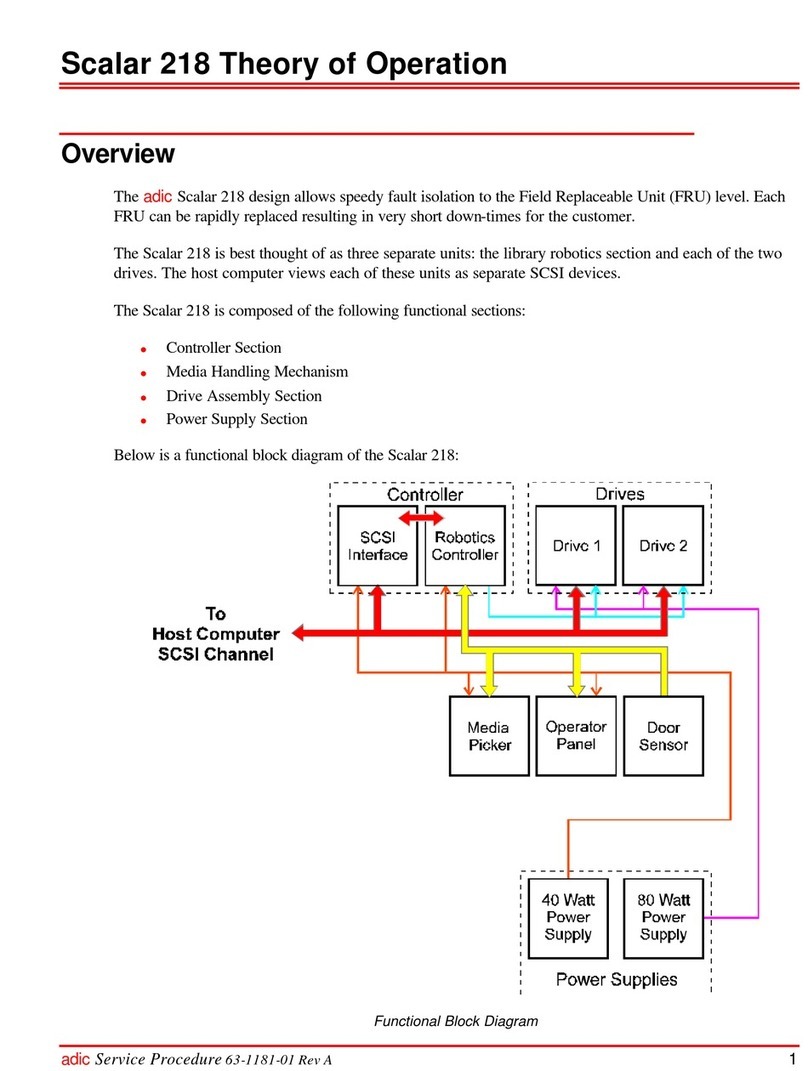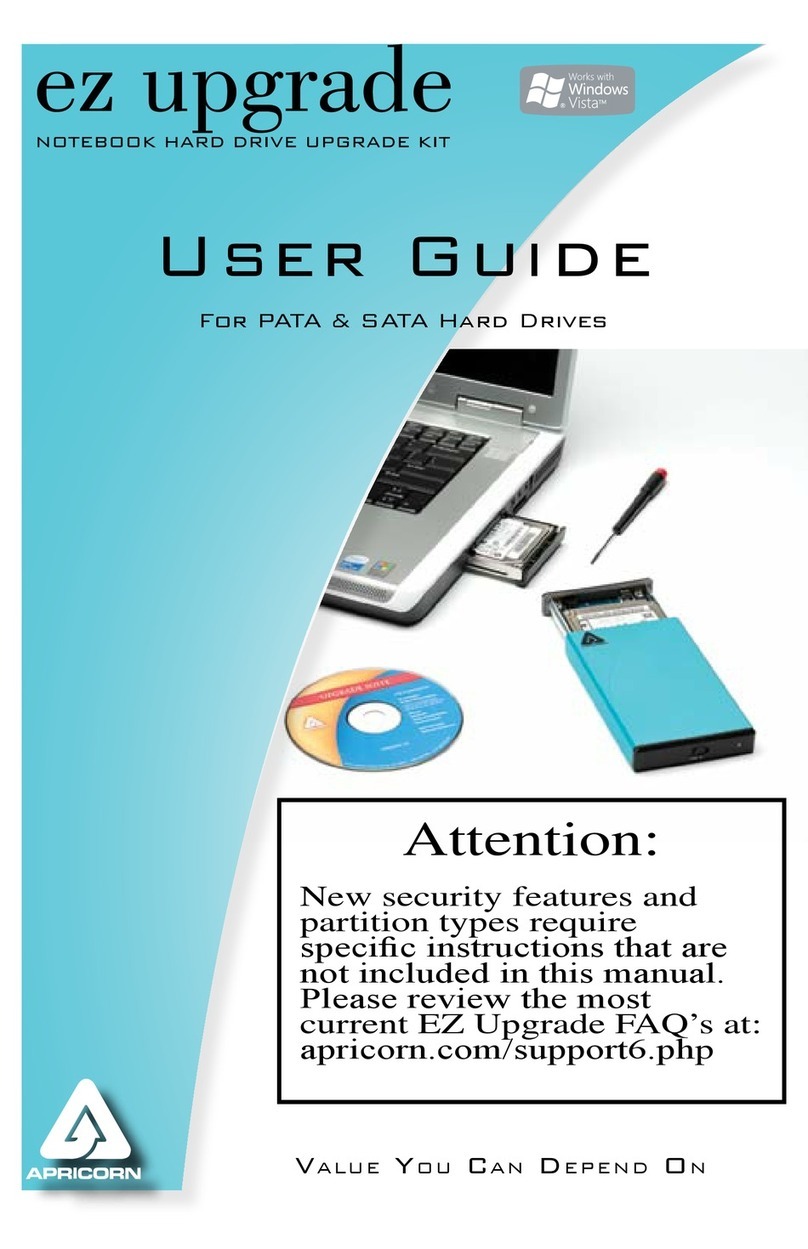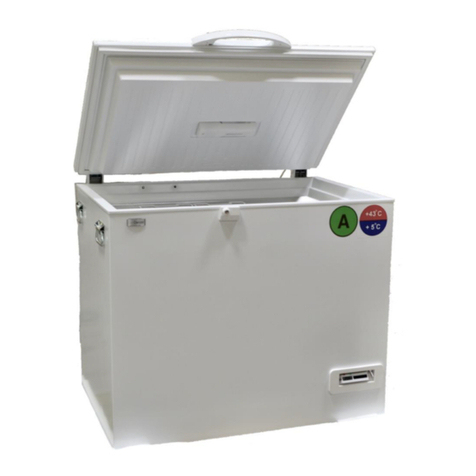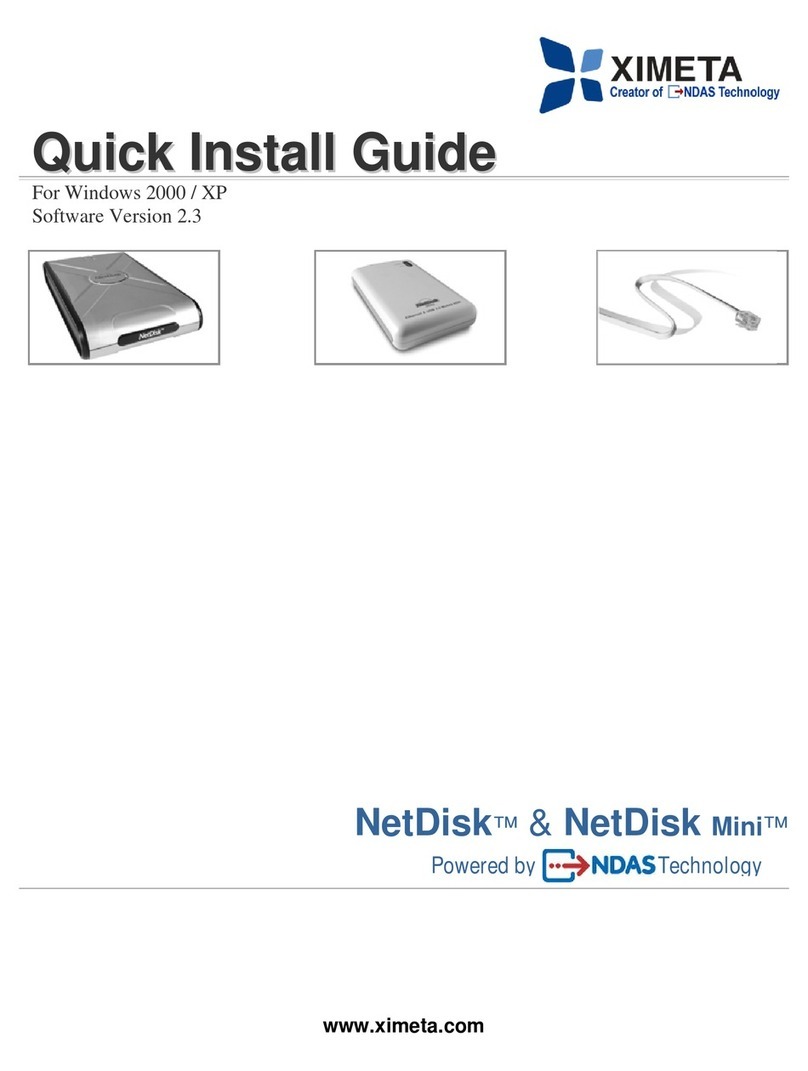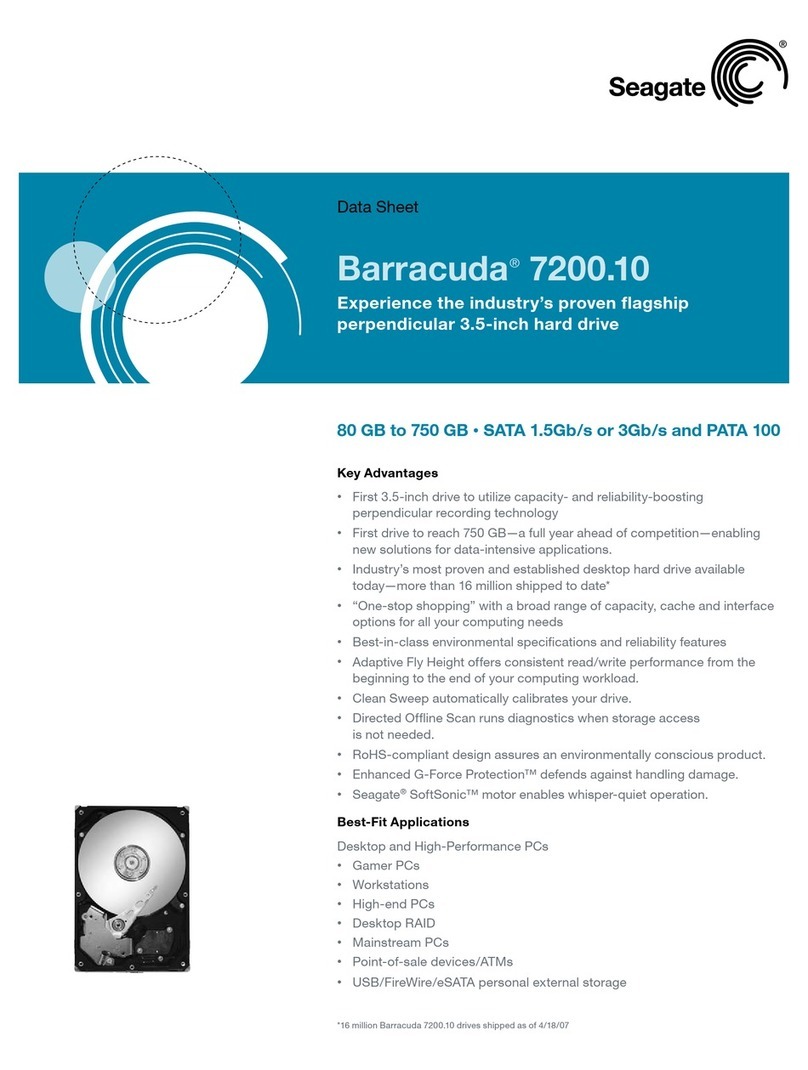Mercury Systems ASURRE-Stor ASD256 User manual

Copyright 2020 Mercury Systems. May only be reproduced in its original form (without revision)
Rev. 1.5.1 February 2020 © 2020 Mercury Systems. All rights reserved
Mercury Systems ASURRE-Stor®SSD
Administrative Guidance
Mercury Systems ASURRE-Stor®
ASD256/512 and ADR256/512
Solid State Self-Encrypting Drives
Non-Proprietary Administrative Guidance
(Firmware revision 1.5.1 and Hardware revision 3.0)
Date: February 4, 2020
Document revision 1.5.1

Mercury Systems ASURRE-Stor®SSD
Administrative Guidance
Copyright 2020 Mercury Systems. May only be reproduced in its original form (without revision)
Rev. 1.5.1 February 2020 © 2020 Mercury Systems. All rights reserved Mercury Systems, Inc. • (602) 437-1520 • www.mrcy.com
2
Table of Contents
Reference documentation ........................................................................................................................... 4
1Introduction ........................................................................................................................................... 6
2Product Description............................................................................................................................... 6
3Product Configuration and Deployment............................................................................................... 6
4Deployed TOE usage scenario: .............................................................................................................. 6
5Failed attempts penalty......................................................................................................................... 7
6TOE operation prior BLACK key fill........................................................................................................ 8
7Power States .......................................................................................................................................... 8
8Immediate Key destruction................................................................................................................... 8
9Key Recovery.......................................................................................................................................... 8
10 Product Identification............................................................................................................................ 8
11 Evaluated Configuration........................................................................................................................ 9
12 Part numbers .......................................................................................................................................10
13 Scope of evaluation .............................................................................................................................11
14 Operating Environment....................................................................................................................... 11
15 Operating environment assumptions and requirements................................................................... 12
16 Unattended operation......................................................................................................................... 13
17 TOE state when shipped from Mercury Systems................................................................................13
18 Secure Configuration ...........................................................................................................................13
19 The Mercury Systems MDU Utility...................................................................................................... 15
20 Changing the BEV (KEK) and BLACK key after the TOE is configured................................................. 16
21 Changing the User or Master ATA Password after the TOE is configured......................................... 16
22 Ports on the ASURRE-Stor®SSD ..........................................................................................................16
23 Installing the TOE into a host system..................................................................................................17
24 Roles..................................................................................................................................................... 19
25 Product Updates ..................................................................................................................................19
26 Physical Security ..................................................................................................................................20
27 Electromagnetic Interference and Compatibility (EMI/EMC) ............................................................20
28 Mitigation of Other Attacks Policy......................................................................................................20
29 Security Guidance Summary ............................................................................................................... 21
30 Change log............................................................................................................................................ 23

Mercury Systems ASURRE-Stor®SSD
Administrative Guidance
Copyright 2020 Mercury Systems. May only be reproduced in its original form (without revision)
Rev. 1.5.1 February 2020 © 2020 Mercury Systems. All rights reserved Mercury Systems, Inc. • (602) 437-1520 • www.mrcy.com
3
List of Tables
Table 1: References............................................................................................................................................................... 4
Table 2: Additional support documentation available from Mercury Systems.................................................................... 4
Table 3: Acronyms and Definitions ....................................................................................................................................... 5
Table 4: Part number summary .......................................................................................................................................... 10
Table 5: CC Compliant modes ............................................................................................................................................. 11
Table 6: TOE Port Summary ................................................................................................................................................ 17
Table 7: LED Indicator Port ................................................................................................................................................. 17
Table 8: Password strength in bits...................................................................................................................................... 21
List of Figures
Figure 1: View of the holographic label located in the center of the main label. ................................................................ 9
Figure 2: Images of the ASURRE-Stor®SSD........................................................................................................................... 9
Figure 3: Diagram of operation in Mode 1, ATA Password with self-generated Permanent key....................................... 13
Figure 4: Diagram of operation in Mode 6, ATA Password with KEK and BLACK key......................................................... 14
Figure 5: MDU utility top level screen ................................................................................................................................ 15
Figure 6: Ports on the TOE ................................................................................................................................................. 16
Figure 7: SATA power connector with 12 V pin (P13, P14, P15) removed to show pin shorts........................................... 18
Figure 8: SATA connectors with separate pins ................................................................................................................... 18
Figure 9: Screw head in daylight......................................................................................................................................... 22
Figure 10: After strong UV exposure .................................................................................................................................. 22
Figure 11: Screw head in UV light....................................................................................................................................... 22

Mercury Systems ASURRE-Stor®SSD
Administrative Guidance
Copyright 2020 Mercury Systems. May only be reproduced in its original form (without revision)
Rev. 1.5.1 February 2020 © 2020 Mercury Systems. All rights reserved Mercury Systems, Inc. • (602) 437-1520 • www.mrcy.com
4
Reference documentation
Acronym
Full Specification Name
ATA Specification
ATA7 Specification
The ATA specification defines industry standard storage commands used by the TOE.
The document is available on the T13.org website.
D1532v1r4b-AT_Attachment_with_Packet_Interface_-_7_Volume_1.pdf
cPP
Collaborative Protection Profile for Full Drive Encryption - Encryption Engine v2.0 January 2, 2019.
Collaborative Protection Profile for Full Drive Encryption –Authorization Acquisition v2.0, January 2, 2019.
Filenames: CPP_FDE_EE_V2.0E.pdf, CPP_FDE_AA_V2.0E.pdf
FIPS140-2
NIST, Security Requirements for Cryptographic TOEs, May 25, 2001
ST
Security Target for Mercury Systems ASURRE-Stor®Solid State Self-Encrypting Drives
NIST 800-38F
NIST Special Publication:
Recommendation for Block Cipher Modes of Operation: Methods for Key Wrapping
Table 1: References
Document name
Description
MDU User’s Guide
(mduUsersGuide.pdf)
This manual describes the MDU utility. Chapters in the document include screen shots
and simple to follow step-by-step instructions to guide the Crypto Officer through the
process of performing the initial secure configuration of the TOE.
Please note that use of the MDU utility is optional and not part of the evaluation.
Programmer’s Guide or
SSD Programmer’s Guide
(ssdProgrammersGuide.pdf)
This document provides detailed register-level information describing how to use
commands/services supported by the TOE that allow filling of keys and configuring
security features. Designers intending to create their own version of the Mercury
Systems MDU utility use this document as a reference manual.
Please note that use of this document is optional and not part of the evaluation.
SSD User’s Hardware Setup Guide
(ssdUsersHardwareSetupGuide.pdf)
This document is intended for the novice user of secure SSDs in defense applications. It
describes how to connect the TOE to a host system and how to connect external
switches to the SATA Power Segment Port to add external Secure Erase Trigger
capability. The document also contains basic information describing some of the key
management features of the TOE.
Please note that use of this document is optional and not part of the evaluation.
SSD Secure Configuration Programmer’s Guide
(ssdSecureConfigurationProgrammersGuide.pdf)
This document is intended for users desiring to implement their own ASURRE-Stor®
configuration tools using standard SATA commands. The document provides the low
level details required to perform configuration operations replicated in the MDU utility.
This document is part of the evaluated administrative guidance for the TOE, and is
available directly from Mercury.
Table 2: Additional support documentation available from Mercury Systems

Mercury Systems ASURRE-Stor®SSD
Administrative Guidance
Copyright 2020 Mercury Systems. May only be reproduced in its original form (without revision)
Rev. 1.5.1 February 2020 © 2020 Mercury Systems. All rights reserved Mercury Systems, Inc. • (602) 437-1520 • www.mrcy.com
5
Acronym
Definition
ArmorTM Processor
This is the Mercury Systems marketing name for the combination of the TOE firmware and TOE hardware.
ATA Specification
ATA7 Specification
The ATA specification defines the operation of ATA based storage devices. The document defines the functional behavior,
commands, and software interface for devices that implement the ATA interface. The specification is available on the
T13.org website.
ATA commands
SATA commands
Storage commands defined by the industry ATA standard. Volume 1 of the specification has the command descriptions.
D1532v1r4b-AT_Attachment_with_Packet_Interface_-_7_Volume_1.pdf
BEV
Border Encryption Value. In this document, the BEV and KEK (Key Encryption Key) are used interchangeably.
BLACK DEK
An encrypted version of the media DEK (Data Encryption Key)
BLACK KEK
An encrypted version of the KEK (Key Encryption Key). The KEK is used to decrypt the BLACK DEK.
CC
Common Criteria
CC cPP
Common Criteria collaborative Protection Profile
CSP
Critical Security Parameter, see [FIPS 140-2]
CMVP
Cryptographic Module Validation Program
COMSEC
Abbreviation for Communications Security. The methods and disciplines needed to ensure communications security.
DEK
Data Encryption Key. The key used to encrypt or decrypt user data.
ECDSA
Elliptic Curve Digital Signature Algorithm; specified in ANS X9.62. FIPS PUB 186-4
FAST CLEAR
For Defense SSDs, Fast Clear is an operation that erases the NAND media using the NAND manufacturers ERASE operation.
In addition, the encryption key and potentially other CSP are destroyed. Which CSP is destroyed varies by manufacturer.
FIPS
Federal Information Processing Standards
FDE
Full Drive Encryption
HMAC
Keyed-Hash Message Authentication Code
IDENTIFY DEVICE COMMAND
IDENTIFY DEVICE is an industry standard ATA command used by host systems to determine features supported by an
attached storage device. Products must support this command to be compatible with the ATA specification. Refer to the
IDENTIFY DEVICE command and Table 16 of volume 1 of the ATA specification pages 115-122.
KEK
Key Encryption Key. A key used to wrap (AES key wrap, SP 800-38F) or un wrap (AES key wrap, SP 800-38F) the DEK.
LED
Light Emitting Diode
LVTTL
3.3 V Low Voltage Transistor-Transistor Logic.
MASTER ATA PASSWORD
Password defined by the ATA specification for use by an Administrator or Crypto Officer. The ATA specification supports a
Security Mode Feature Set of two passwords, a Master ATA Password and a User ATA Password. The passwords restrict
access to data stored on the device. ATA also defines two capability levels, High and Maximum, which determine how the
TOE behaves when the Master Password issued to unlock the device. Refer to the ATA7 specification V1 page 22.
MDU
MDU Utility
Mercury Systems Drive Utility. MDU is a Windows GUI utility that allows a Crypto Officer to quickly and easily perform the
initial secure configuration of the Mercury Systems Asurre-Stor®SSD.
Please note that use of the MDU utility is optional and not part of the evaluation.
Non-Volatile memory (NVM)
Non-Volatile Memory is a memory technology that retains data across power cycles. (e.g., EEPROM, NAND Flash)
OPAL
A security specification defined by the Trusted Computer group that utilizes a TPM in a computer host.
RBG or RNG or NDRBG or NDRNG
Random Bit Generator, Random Noise Generator, Non-deterministic Random Bit Generator, Non-deterministic Random
Number Generator.
SANITIZE or SANITIZE PROTOCOL
(in reference to defense SSDs)
Sanitize is an operation that runs repeated erase and pattern over-write operations of the storage media. In addition, the
encryption key and other CSP (if any) are destroyed. Exactly which CSP is destroyed varies by manufacturer.
SATA
Serial ATA. A bus interface between a host computer and a mass storage device using a serial version of the ATA
specification. The specification is available from the Serial ATA International Organization.
SECTOR or LBA
Unit of storage on a hard drive. Typically 512 bytes. Same as an LBA.
SECURE ERASE
or
ZEROIZE
Secure Erase and Zeroize and many trademarked variations imply some sort of erase operation that destroys/erases the
storage media and potentially CSP as well. Exactly what is destroyed, storage media, keys, passwords, KEKs, etc. varies
from one manufacturer to another.
SHA
Secure Hash Algorithm (FIPS 180-4)
SED
Self-Encrypting Drive.
SMART or S.M.A.R.T.
SMART stands for Self-Monitoring, Analysis and Reporting Technology. As part of the ATA specification, SMART
commands provide a way for vendors to implement custom commands that enhance functionality of products by allowing
entry of security parameters and reporting of health parameters such as, operation logs, temperature, and errors.
SSD
Solid State Hard Drive. An SSD is a 100% solid state version of a standard mechanical hard drive.
SSDs use NAND flash devices as the storage media vs a rotating magnetic platter for the storage media.
SFF-8201
Specification for 2.5” Form Factor Drive Dimensions developed by the SFF Committee
ST
Security Target
TOE
Target Of Evaluation
TCG and TPM
Trusted Computer Group and Trusted Platform Module
TRRUST-PurgeTM
TRRUST-PurgeTM is a Mercury Systems trademarked name for an operation that destroys the encryption key in Mercury
Systems SSDs by over-writing the key value with zeros.
USER ATA PASSWORD
Password defined by the ATA specification for use by a user of a storage device. See Master ATA Password above and
refer to the ATA specification (ATA7) volume 1 page 22 for additional details.
XTS
AES encryption utilizes block cipher modes. XTS is the block cipher mode most commonly used in secure storage.
Table 3: Acronyms and Definitions

Mercury Systems ASURRE-Stor®SSD
Administrative Guidance
Copyright 2020 Mercury Systems. May only be reproduced in its original form (without revision)
Rev. 1.5.1 February 2020 © 2020 Mercury Systems. All rights reserved Mercury Systems, Inc. • (602) 437-1520 • www.mrcy.com
6
1Introduction
This document provides administrative guidance for the ASURRE-Stor®2.5” Solid State encrypting hard drive, hereafter
denoted TOE or ASURRE-Stor®SSD. The document describes how to identify the product, install it in a typical host
system, and describes the steps necessary to begin the initial secure configuration of the TOE. The document is
intended for use by the Administrator or Crypto Officer responsible for configuring the product prior to field
deployment.
The reader may notice that the document refers to a value called the BEV. The BEV is a term that originated in the FDE
Collaborative Protection Profile and stands for Border Encryption Value. The BEV performs the same function in the
ASURRE-Stor®SSD as a KEK (Key Encryption Key) and is used to decrypt the media DEK (Data Encryption Key). The
document uses the terms BEV and KEK interchangeably.
2Product Description
The Mercury Systems ASURRE-Stor®SSD is a secure solid state hard drive. A hard drive is a storage device used in
computers as the primary booting device to load the Operating System or as a device to store large amounts of data. In
the simplest of terms, the ASURRE-Stor®SSD is a highly secure version of an industry standard 2.5” SATA hard drive.
Unlike most other secure solid state drive products, the Mercury Systems ASURRE-Stor®SSD does not depend on a
TPM module, TCG, or OPAL to implement security. Instead the ASURRE-Stor®SSD implements security using
hardware-based AES-256 XTS encryption and key management techniques that are compatible with the industry
standard ATA specification. These techniques provide superior and flexible solutions for mission critical defense
applications and have no requirements for unencrypted shadow MBR sectors or 3rd party Opal software.
The ASURRE-Stor®SSD was evaluated against the Common Criteria Collaborative Protection Profile for Full Drive
Encryption - Encryption Engine, v2.0 dated January 2, 2019 and the Collaborative Protection Profile for Full Drive
Encryption –Authorization Acquisition, v2.0 dated January 2, 2019.
3Product Configuration and Deployment
The Mercury Systems ASURRE-Stor®SSD is shipped with the optional MDU configuration utility. While the MDU
provides an easier-to-use method of performing some of the required administrative configuration functions, the MDU
is a utility provided by Mercury that is not part of the evaluated configuration and this should be taken into account by
users of the system. The use of this utility was not evaluated. Therefore, the interfaces used as part of the evaluation
are the direct SATA interfaces.
The programmer's guide and security configuration programmer's guide describe the administrative interface that is
used in the evaluated configuration that was tested. The configuration instructions for activities mandated by the ST
are provided in this document; locations of the instructions are given by reference to the programmer's guides, and for
convenience some references using the MDU visual interface are given as well.
4Deployed TOE usage scenario:
The TOE usage scenario is a re-occurring mission model. The TOE supports two CC compliant modes of operation:
1. ATA password with Self-generated Permanent key (Mode 1)
2. ATA Password with KEK and BLACK key (Mode 6)
Mode 1: ATA password with Self-generated Permanent key
This scenario begins with the Crypto Officer (CO) configuring the TOE in a secure location using MDU or a similar
custom utility program. The CO configures the TOE to operate in Mode 1. The TOE uses a hardware based NDRNG and
a DRBG algorithm to self-generate a random DEK. The DEK consists of a 256-bit AES key and a different 256-bit XTS key.
The CO enters a password of up to 64 characters. The TOE conditions the password with PBKDF (Password Based Key
Derivation Function SP 800-132) to create a derived 256-bit key (BEV/KEK) that the TOE uses to AES key wrap (AES-KW-

Mercury Systems ASURRE-Stor®SSD
Administrative Guidance
Copyright 2020 Mercury Systems. May only be reproduced in its original form (without revision)
Rev. 1.5.1 February 2020 © 2020 Mercury Systems. All rights reserved Mercury Systems, Inc. • (602) 437-1520 • www.mrcy.com
7
256, SP 800‐38F) the DEK. The TOE then overwrites the password that was entered by the CO and the derived key
(BEV/KEK) resulting from the PBKDF function and saves the wrapped DEK in NVRAM. After configuration completes,
the CO exits the Crypto Officer role. At this point the TOE is operational and ready to accept mission data in a User
Role. Mission personnel load mission data into the TOE then turn off TOE power. Removing power purges the DEK
from the TOE. In the powered-off state the TOE contains only the wrapped DEK located in NVRAM.
The TOE is transported to the mission vehicle and installed. The mission vehicle host system provides the password.
The TOE conditions the password with PBKDF to create a derived key (BEV/KEK) that is then used to un-wrap (AES-KW-
256, SP 800‐38F) the DEK. If the unwrap operation completes successfully and the resulting DEK is the correct DEK, the
TOE enters a normal operating mode which allows the mission to begin. When the mission completes, TOE data, if
applicable, is retrieved.
The TOE retains the AES wrapped DEK across power cycles in NVRAM, however; the password must fill on each power
cycle to complete the key chain.
Mode 6: ATA password with KEK and BLACK key
Pre-configuration operations, separate from the TOE, are described below.
In Mode 6, the Crypto Officer (CO) begins by creating three keys, a 256-bit BEV(KEK), a 512-bit DEK, and a 576-bit BLACK
key. The DEK consists of a 256-bit AES key and a different 256-bit XTS key. The CO uses the BEV(KEK) and AES key wrap
(AES-KW-256, SP 800-38F) to wrap the DEK. The resulting wrapped DEK is referred to as the BLACK key. The CO and
mission personnel must retain the BLACK key for filling the TOE at each mission power-on cycle.
TOE configuration operations (performed on the TOE):
The CO configures the TOE using MDU or a similar custom utility program to operate in Mode 6. The CO fills the
BEV(KEK) and enters a password of up to 64 characters. The TOE conditions the password with PBKDF (Password Based
Key Derivation Function SP 800-132) to create a derived 256-bit key that the TOE uses to AES key wrap (AES-KW-256, SP
800‐38F) the BEV(KEK). The TOE saves the wrapped BEV(KEK) in NVRAM. The CO then cycles TOE power off then on
again.
Next, the CO fills the TOE with the password followed by the BLACK key. The TOE conditions the password using PBKDF
(Password Based Key Derivation Function SP 800-132) to create a derived intermediate key and uses it to AES unwrap
(AES-KW-256, SP 800‐38F) the BEV(KEK). The TOE then uses the BEV(KEK) to unwrap the BLACK key re-creating the DEK
and completing the key chain. The TOE overwrites the password and derived key. The CO exits the Crypto Officer role.
At this point the TOE is operational and ready to accept mission data in a User Role. Mission personnel load mission
data into the TOE then turn off TOE power. Removing power purges the DEK and unwrapped BEV from the TOE RAM.
In the powered off state, the TOE contains only the wrapped BEV(KEK) in NVRAM.
The TOE is transported to the mission vehicle and installed. The mission vehicle host system provides the password and
the BLACK key. The TOE conditions the password with PBKDF to create a derived intermediate key that the TOE uses to
unwrap the BEV(KEK) previously saved in NVRAM. If the unwrap operation succeeds, the TOE uses the BEV(KEK) to
unwrap the BLACK key. If the unwrap operation succeeds and the resulting DEK is the correct DEK, the TOE enters a
normal operating mode which allows the mission to begin.
When the mission completes, TOE data, if applicable, is retrieved.
The TOE retains the AES wrapped BEV(KEK) in NVRAM across power cycles. The password and BLACK key must fill on
each power cycle to complete the key chain.
5Failed attempts penalty
The TOE supports a feature to limit the number of sequential failed attempts to enter correct passwords, key values,
and correct digital signature during firmware updates. When the maximum number of failed attempts count is

Mercury Systems ASURRE-Stor®SSD
Administrative Guidance
Copyright 2020 Mercury Systems. May only be reproduced in its original form (without revision)
Rev. 1.5.1 February 2020 © 2020 Mercury Systems. All rights reserved Mercury Systems, Inc. • (602) 437-1520 • www.mrcy.com
8
exceeded, the TOE performs a zeroize/clear operation that erases the wrapped DEK (mode 1) and wrapped BEV(KEK)
(Mode 6), as well as all of the NAND media. As part of the Administrative Guidance, the CO is instructed to enable this
feature and use a failed attempts count of 1, 5, 10 or 15.
6TOE operation prior BLACK key fill
The key chain for the TOE is not complete until the password (mode 1 and 6) and BLACK key (mode 6) fill. After the CO
completes the initial secure configuration, and prior to password and/or BLACK key fill, the TOE responds to
informational ATA commands as required by the ATA specification. In response to these commands the TOE returns
information and attributes about the TOE that the attached host system requires to properly communicate with the
TOE. The TOE returns values of all 0xFF for read user data commands and a failure for any attempt to write user data.
7Power States
The TOE automatically enforces operation in ACPI device power states D0 and D3. Specifically, D0 and D3 (cold). D0 is
defined as the fully on, active state, and D3 (cold) is the state where the device is fully powered off. The TOE supports
other power saving states as required by the ATA specification; however, as part of the Administrative Guidance, the
CO is instructed to disable other power states and force the TOE to only support D0 and D3 (cold).
To authenticate and enter power state D0 from a power-on cycle, the TOE requires an ATA password in Modes 1 and 6.
Additionally, the correct BLACK key is required in Mode 6. Access to plain text is only allowed when authentication
completes successfully. When power is removed from the TOE, the TOE enters power state D3 (cold), a fully powered-
off condition. Only power state D0 allows access to plain text data. Since SSDs never receive warning of imminent
power loss, the design of the TOE assures that there are no scenarios where an unexpected power loss can result in the
TOE entering a non-compliant power state.
8Immediate Key destruction
The TOE never uses the NAND storage media to hold encryption keys, passwords, or any intermediate security related
variables. Instead, the DEK resides in the NAND controller’s RAM and wrapped keys reside in a separate NVRAM. This
architectural model allows the TOE to immediately destroy key information regardless of ongoing operations in NAND
such as garbage collection, wear-leveling, Block Retirement, or any SATA operations including TRIM.
9Key Recovery
The TOE contains no mechanism to allow export or recovery of encryption keys or wrapped keys.
10 Product Identification
As with any secure product, it is important to verify that the product received from Mercury Systems has not been
tampered with or replaced with a similar but non-compliant product during shipment. For an additional fee, Mercury
Systems can ship the product using FedEx Custom Critical services. Refer to the FedEx website to determine what
FedEx services match required security needs.
The Administrator or CO responsible for configuring the product prior to field deployment is encouraged to consider
the guidelines below to ensure the authenticity and integrity of the received TOE.
•The main label of the TOE contains the product part number. Referring to the part number section of this
document, verify that the part number on the main label matches one of the part numbers in Table 4 and also
matches what was ordered from Mercury Systems.
•The TOE includes a difficult to duplicate holographic label shown in Figure 1. The label isn’t intended to be a
tamper seal, however the label can be difficult to remove and will show signs of tearing or discoloration if
improperly handled during a tamper event.

Mercury Systems ASURRE-Stor®SSD
Administrative Guidance
Copyright 2020 Mercury Systems. May only be reproduced in its original form (without revision)
Rev. 1.5.1 February 2020 © 2020 Mercury Systems. All rights reserved Mercury Systems, Inc. • (602) 437-1520 • www.mrcy.com
9
•Verify that the Firmware version (FW) and Hardware revision (HW) printed on the main label matches the
following: “FW 1.5.1 HW 3.0”
•The main label contains a Common Criteria validation report number. Verify that the validation report number
(VR#) matches the number listed on the CC certificate on the NIAP website.
•The heads of two exposed enclosure corner screws are filled with an orange material that obscures a custom
screw head pattern. Inspect the two corner screws for evidence of tampering. Since the screws are very small,
inspection with magnification is recommended.
•Use the SATA command described in SSD Secure Configuration Programmer’s Guide, section 2.2, to verify that
the TOE reports Firmware revision number 1.5.1. Alternatively, the MDU utility can be used (Refer to MDU
section) to verify that the TOE reports Firmware revision number 1.5.1.
•Images of the ASURRE-Stor®SSD appear in Figure 2. Inspect the TOE to verify that the product received
matches the images of Figure 1 and 2.
11 Evaluated Configuration
The TOE evaluation covers the following hardware models with Firmware 1.5.1 and Hardware revision 3.0.
ASD256AM2R, ASD512AM2R, ADR256AM2R, ADR512AM2R
The physical boundary of the TOE is the drive enclosure.
The TOE can be configured to operate in one of several modes of operation. The modes of operation differ in how the
DEK is established and stored. Two modes are CC compliant and are covered by this evaluation.
•ATA password with Self-generated Permanent key
•ATA password with KEK with BLACK Key
Figure 1: View of the holographic label located in the center of the main label.
Figure 2: Images of the ASURRE-Stor®SSD

Mercury Systems ASURRE-Stor®SSD
Administrative Guidance
Copyright 2020 Mercury Systems. May only be reproduced in its original form (without revision)
Rev. 1.5.1 February 2020 © 2020 Mercury Systems. All rights reserved Mercury Systems, Inc. • (602) 437-1520 • www.mrcy.com
10
12 Part numbers
The CC compliant part numbers are shown below in Table 4.
Part number
Part number suffix description
ASD256AM2R-xyzIC
Option Field x:
0 = Standard product.
1 = Omit the LED Indicator Port and the Write Protect Port.
Option Field y:
0 = Standard product.
1 = Electrically isolate enclosure.
2 = Erase pin 1 option. Trigger an erase/sanitize operation from SATA pin P1.
Option Field z:
0 = Standard product.
1 = Legacy erase option. Same as field y Option 2 except from SATA pin P13.
2 = Hypertronics Rugged connector
3 = Option 1 and 2
4 = Erase pin low option. Same as field y Option 2 except from SATA pin P4 low.
5 = NA
6 = Option 2 and 4
8 = Amphenol Rugged Connector
9 = Option 8 and 1
C= Option 8 and 4
ASD512AM2R-xyzIC
Same options as ASD256AM2R-xyzIC
ADR256AM2R-xyzIC
Same options as ASD256AM2R-xyzIC (This model has reduced overprovisioning)
ADR512AM2R-xyzIC
Same options as ASD256AM2R-xyzIC (This model has reduced overprovisioning)
Table 4: Part number summary

Mercury Systems ASURRE-Stor®SSD
Administrative Guidance
Copyright 2020 Mercury Systems. May only be reproduced in its original form (without revision)
Rev. 1.5.1 February 2020 © 2020 Mercury Systems. All rights reserved Mercury Systems, Inc. • (602) 437-1520 • www.mrcy.com
11
13 Scope of evaluation
The ASURRE-Stor®SSD was evaluated to the security functional requirements specified in the document “Security
Target for Mercury Systems ASURRE-Stor®Solid State Self-Encrypting Drives”.
The TOE does not depend on a TPM (Trusted Platform Module) or OPAL (a security specification) to provide security.
Instead the TOE supports 6 FIPS 140-2 approved modes, of which, two modes satisfy the requirements of the
Collaborative Protection Profile for Full Drive Encryption - Encryption Engine, v2.0 dated January 2, 2019 and the
Collaborative Protection Profile for Full Drive Encryption –Authorization Acquisition, v2.0 dated January 2, 2019.
To provide consistency to the FIPS Security Policy documentation, the CC documentation for the ASURRE-Stor®SSD
uses the same numbering for the key management modes as the FIPS 140-2 Security Policy. Using the FIPS mode
numbering scheme, the TOE supports CC compliant modes of Mode 1 and Mode 6. No other key management modes
were evaluated during the course of the CC-Evaluation.
Mode #
Mode name
Key Chain
1
•Self-generated random
Permanent key with ATA
Password
•
•
•
•During configuration:
•The TOE self-generates a random 256-bit AES key and different 256-bit XTS key for use as the media
DEK. A password is filled and is conditioned by PBKDF(SP 800-132) to create an intermediate
derived key that is used to AES key wrap (AES-KW-256, SP 800‐38F) the DEK. The wrapped DEK is
saved in NVRAM.
•
•During normal operation:
•On each power cycle, the password must fill. The TOE conditions the password with PBKDF to
create an intermediate derived key (BEV/KEK) that is then used to un-wrap (AES-KW-256, SP 800‐
38F) the DEK previously saved in NVRAM.
6
•ATA password with KEK
•and BLACK key
•
•Pre-configuration:
The CO creates two keys, a 256-bit BEV(KEK) and a 512-bit DEK. The DEK consists of a 256-bit AES
key and a different 256-bit XTS key. The CO creates a password of up to 64 characters. The CO
conditions the password using PBKDF (SP 800-132) to create a derived 256-bit key used to AES key
wrap (AES-KW-256, SP 800‐38F) the DEK to create the BLACK key.
•During Configuration:
The CO fills the BEV(KEK) and password into the TOE. The TOE conditions the password with PBKDF
(SP 800-132) creating a derived 256-bit key used to AES key wrap (AES-KW-256, SP 800‐38F) the
BEV(KEK). The TOE saves the wrapped BEV(KEK) in NVRAM.
•
•During normal operation:
•On each power cycle, the user enters the password and BLACK key. The password is conditioned
with PBKDF creating a derived 256-bit key used to un-wrap the BEV/KEK previously saved in
NVRAM. The un-wrapped BEV/KEK is used to un-wrap the BLACK key to re-create the DEK.
Table 5: CC Compliant modes
14 Operating Environment
The ASURRE-Stor®SSD is compliant and compatible with the industry standard SATA specification and conforms to the
ATA7 specification and command set. The ASURRE-Stor®SSD will function correctly in all products that include a
standard SATA interface and are compliant to the SATA and ATA7 specification.

Mercury Systems ASURRE-Stor®SSD
Administrative Guidance
Copyright 2020 Mercury Systems. May only be reproduced in its original form (without revision)
Rev. 1.5.1 February 2020 © 2020 Mercury Systems. All rights reserved Mercury Systems, Inc. • (602) 437-1520 • www.mrcy.com
12
15 Operating environment assumptions and requirements
The guidance for the ASURRE-Stor®SSD makes the following assumptions:
•The TOE encrypts all data with AES-256 XTS. There are no configuration options or support for different key sizes.
•The TOE is not dependent on the operational environment to perform DEK purging or memory clear operations.
All operations that perform clear and purge operations, once triggered, operate indecently of the host SATA
interface.
•The ASURRE-Stor®SSD does not support TCG or require a trusted platform module for secure operation.
•The ASURRE-Stor®SSD is located in a secure environment during the initial secure configuration.
•The Administrator or Crypto Officer connects the ASURRE-Stor®SSD to a host system that includes the electrical
and software interface support necessary to implement an industry standard SATA interface as defined by the
Serial ATA specification, revision 2.6.
•When configuring the TOE using a custom designed utility, the Administrator shall verify that the custom utility
configures the TOE to the same configuration described by the SSD Secure Configuration Programmer’s Guide
configuration procedure.
•Administrators preferably fill the password, BLACK key, and BEV(KEK) over the standard SATA interface using the
MDU utility. The BLACK key and BEV(KEK) can also fill from a 2-pin serial interface located on pins P14 and P15 of
the SATA connector. This interface is only used when filling with COMSEC controlled DS-101 key fill devices.
When utilizing COMSEC key fill devices, P14 acts as a 3.3 V, RS-232 Rx signal and Pin P15 acts as a 3.3 V, RS-232 Tx
signal. The protocol settings for the key fill device should be set to 2400 baud, 8 data bits, 1 stop bit, and no
parity. Mercury Systems provides technical support to help interface with COMSEC key fill devices and can
provide the technical details needed to create custom key fill cables and any needed voltage translation.
•The Administrator and/or system designers shall implement application techniques, safeguards, and/or
procedures to assure that power is removed from the TOE, state D3 (cold), when the host system is left
unattended. On removal of power, the TOE purges the DEK key and enters a full-off state in less than 20
milliseconds.
•The Administrator shall verify that TOE users are trained on how to power-off the host system and TOE.
•The ASURRE-Stor®SSD accepts passwords lengths of up to 64, 8-bit bytes. Administrators and Crypto Officers
shall enforce password lengths and complexity to provide suitable security strength.
•After completing the secure configuration of the TOE, the Administrator or Crypto Officer will verify that the TOE
is operating in a CC compliant configuration. Use the SSD Secure Configuration Programmer's Guide to determine
the SATA commands required to verify this information.
•The TOE product is compliant to the EE and AA protection profiles. It is assumed that the external interface
providing the password to the AA portion of the TOE, is in close enough proximity to the TOE during operation
that a threat agent has very little opportunity to interpose itself in the channel between the two without the user
noticing and taking appropriate actions.
•The Administrator understands that Mercury Systems supplies the TOE in an erased state. The TOE contains no
data when delivered by Mercury systems. The Administrator shall not store information on the TOE until after
completing the initial secure configuration procedure.
•The Administrator shall implement methods and procedures to assure that the host system is free of malware that
could interfere with the correct operation and power-off procedures of the host system connected to the TOE.
•The Administrator is responsible for completing the initial secure configuration of the TOE and for generating
password, BEV(KEK), and BLACK key values that meet the requirements of the EE and AA protection profiles for
both strength and entropy.
•The Administrator shall train any users involved in the provisioning of the TOE in the methods and procedures to
properly handle, store, and secure the password, BEV(KEK) and BLACK key values. For example, the password and
BLACK key values should be stored separately from the host system and the TOE.

Mercury Systems ASURRE-Stor®SSD
Administrative Guidance
Copyright 2020 Mercury Systems. May only be reproduced in its original form (without revision)
Rev. 1.5.1 February 2020 © 2020 Mercury Systems. All rights reserved Mercury Systems, Inc. • (602) 437-1520 • www.mrcy.com
13
16 Unattended operation
The TOE is compliant to the Serial ATA specification. The SATA specification defines a set of commands the host system
uses to write/read data to/from the TOE. Since the TOE cannot independently initiate communication with the host,
the TOE has no mechanism to determine when a host system is unattended, or for example, in a lock-screen or sleep
state. For this reason, the Administrator and system designers must implement host system application techniques,
safeguards, and/or procedures that remove power from the TOE whenever the host platform is left unattended. Upon
removal of power, the TOE purges the DEK and moves to a complete power-off state in less than 20 milliseconds.
17 TOE state when shipped from Mercury Systems
For simplicity of initial setup at the customer site, ASURRE-Stor®SSDs ship from Mercury Systems fully erased and in a
non-compliant mode. The Administrator or Crypto Officer taking possession of factory delivered ASURRE-Stor®SSDs
must perform an initial secure configuration of each TOE to place the TOE into a CC compliant operating mode prior to
deployment.
18 Secure Configuration
Prior to configuration, the Administrator must determine the appropriate key management mode for operation.
Selecting the mode impacts how the host system interacts with the TOE. In both CC compliant modes, the host system
must supply authentication that allows the TOE to complete the key chain. The required authentication is a password
in Mode 1 or a password and a BLACK key in Mode 6. Block diagrams of the two CC compliant modes are shown in
Figure 3 and Figure 4.
In Mode 1, the TOE self generates the media DEK. The ATA Password conditioned by PBKDF (SP 800-132) creates an
intermediate derived key that is used to AES key wrap (AES-KW-256, SP 800‐38F) the DEK. The wrapped DEK is saved in
NVRAM. The ATA Password must be entered on every power-on cycle. The ATA Password is conditioned by PBKDF (SP
800-132) to create a derived key used to un-wrap DEK and allow normal operation.
In Mode 6, the TOE accepts a plain-text BEV(KEK). The TOE uses the ATA password, conditioned by PBKDF (SP 800-132),
to create an intermediate derived key used to AES key wrap (AES-KW-256, SP 800‐38F) the BEV(KEK) The wrapped
BEV(KEK) is saved in NVRAM. During normal operation, the user must enter the password and a BLACK key on every
power-on cycle. The Password is conditioned by PBKDF (SP 800-132) to create a derived key used to un-wrap BEV(KEK)
which is them used to unwrap the BLACK key value to re-create the DEK and allow normal operation.
Figure 3: Diagram of operation in Mode 1, ATA Password with self-generated Permanent key

Mercury Systems ASURRE-Stor®SSD
Administrative Guidance
Copyright 2020 Mercury Systems. May only be reproduced in its original form (without revision)
Rev. 1.5.1 February 2020 © 2020 Mercury Systems. All rights reserved Mercury Systems, Inc. • (602) 437-1520 • www.mrcy.com
14
Direct Configuration
The initial secure configuration of the TOE can be accomplished using standard SATA commands and referencing
register level descriptions defined in the SSD Programmer’s Guide and the SSD Secure Configuration Programmer’s
Guide.
During the secure configuration procedure, specific configuration parameters are configured to CC compliant values.
The TOE parameters that do not affect CC compliance are allowed but were not evaluated. Examples of parameters
required for CC compliance are listed below.
a. “KEK and BLACK DEK” mode must be set to “KEK and BLACK DEK”.
b. The “Key Source” selection is determined by the CO as required by the fielded application.
c. “Require the ATA user password…” (enables the KEK with BLACK key and ATA Password mode). Set the “ATA Password Length” to 64 bytes.
d. Enable the “Secure Erase Trigger” option.
e. Select a “Default Secure Erase Operation”. All erase operations erase the key and are CC compliant.
f. Enable the “Authentication Penalty” by selecting a value of 1, 5, 10, or 15.
g. To prevent the user from changing the firmware after configuration completes, select “Disable” for the “Firmware Updates” option.
h. Disable the “Password Recovery” feature.
i. Verify that the “MSD Settings Log” is set to a value of “Version 3”.
j. Disable the “Intermediate Power Save Mode” option.
k. Define the Configuration Password.
l. Issue the “Execute Security Command” and define a User ATA password.
m. Define and install the BEV(KEK) and BLACK key values.
n. Cycle TOE power, and then verify the TOE is in a (CSfC) CC compliant mode.
The detailed commands to perform these steps are found (in sequential order, with all implementation details
referenced) in section 2 of the SSD Secure Configuration Programmer’s Guide.
Figure 4: Diagram of operation in Mode 6, ATA Password with KEK and BLACK key

Mercury Systems ASURRE-Stor®SSD
Administrative Guidance
Copyright 2020 Mercury Systems. May only be reproduced in its original form (without revision)
Rev. 1.5.1 February 2020 © 2020 Mercury Systems. All rights reserved Mercury Systems, Inc. • (602) 437-1520 • www.mrcy.com
15
19 The Mercury Systems MDU Utility
The initial secure configuration of the TOE can be accomplished using the Mercury Systems MDU Utility, though this is
not evaluated functionality. When using MDU for configuration, connect the ASURRE-Stor®SSD to a PC computer
using standard SATA/Power cables, launching the Mercury Systems MDU utility, then beginning configuration.
The MDU utility runs on Windows XP, Windows 7 and Windows 10. After MDU opens, it may be necessary to press the
“Scan for Hardware Changes” button to scan for Mercury ASURRE-Stor®SSDs, however, MDU generally auto-detects
them. In the “Mercury Drives:” window in the upper left corner, MDU lists all the Mercury Systems ASURRE-Stor®SSDs
detected. Use the cursor to select to a specific TOE and press the “Get drive information” button. This causes MDU to
read the TOE configuration and display it as shown in the screen shot of Figure 5 below.
CC compliant mode indicator
During the secure configuration procedure, specific configuration parameters are configured to CC compliant values.
The TOE parameters that do not affect CC compliance are allowed but were not evaluated. Examples of parameters
required for CC compliance are listed below.
a. “KEK and BLACK DEK” mode must be set to “KEK and BLACK DEK”.
b. The “Key Source” selection is determined by the CO as required by the fielded application.
c. “Require the ATA user password…” (enables the KEK with BLACK key and ATA Password mode). Set the “ATA Password Length” to 64 bytes.
d. Enable the “Secure Erase Trigger” option.
e. Select a “Default Secure Erase Operation”. All erase operations erase the key and are CC compliant.
f. Enable the “Authentication Penalty” by selecting a value of 1, 5, 10, or 15.
g. To prevent the user from changing the firmware after configuration completes, select “Disable” for the “Firmware Updates” option.
h. Disable the “Password Recovery” feature.
i. Verify that the “MSD Settings Log” is set to a value of “Version 3”.
j. Disable the “Intermediate Power Save Mode” option.
k. Define the Configuration Password. Press the “Set Password” button and follow instructions.
l. Use the “Execute Security Command” button and define a User ATA password.
m. From the “Change key and Settings…” window, define and install the BEV(KEK) and BLACK key values.
n. Cycle TOE power, and then use the MDU “Get Drive Information” button to verify the TOE is in a (CSfC) CC compliant mode.
The process to complete the initial secure configuration using MDU is greatly simplified by referring to the MDU User’s
Guide. The MDU User’s Guide provides simple, step-by-step instructions with screen shots taken directly from the
MDU utility. The document guides Administrators and Crypto Officers through the entire secure configuration process.
Refer to section 3 of the MDU User’s Guide for the full configuration procedure.
Figure 5: MDU utility top level screen

Mercury Systems ASURRE-Stor®SSD
Administrative Guidance
Copyright 2020 Mercury Systems. May only be reproduced in its original form (without revision)
Rev. 1.5.1 February 2020 © 2020 Mercury Systems. All rights reserved Mercury Systems, Inc. • (602) 437-1520 • www.mrcy.com
16
20 Changing the BEV (KEK) and BLACK key after the TOE is configured
The TOE verifies that the BLACK key that fills on each power cycle is identical to the BLACK key filled during the initial
secure configuration procedure. This is done both for authentication and to prevent TOE data corruption. In order to
change to a different BLACK key or BEV(KEK) an erase operation is required. The erase operation outlined below erases
the existing BLACK key DEK, BEV(KEK), User ATA Password and the NAND media. The operation also causes the TOE to
prepare to accept new BEV(KEK) and BLACK key values.
A summary of the steps needed to change the key values appears below.
1. Obtain the current TOE configuration Log, and modify the “Default Secure Erase” parameter to “Fast Clear.”
2. Unlock the TOE by entering the correct User ATA Password by sending the “Execute Security Command” command.
3. Send the “Erase the drive” command. The drive green LED on the LED indicator port will flash until the erase operation completes. This will
take less than 8 seconds for the Fast Clear protocol. At this point the drive has no key values, no ATA Password, and the NAND media is
clear. Drive data is forensically unrecoverable.
4. Read the TOE configuration file and modify it to include the new BEV(KEK) value and send the configuration to the TOE
5. Repeat for the BLACK key value.
6. Repeat for the ATA password.
7. Cycle TOE power, enter the ATA password, and issue the “Get Drive Information” command and verify that the TOE is in a CC compliant
mode.
21 Changing the User or Master ATA Password after the TOE is configured
The TOE supports changing the User ATA password after initial configuration. The host system must unlock the TOE by
entering the correct User ATA password, then once unlocked, the host system can change the User ATA password. The
host system can use ATA commands defined in the SSD Programmer’s Guide or the host can use MDU to simplify this
process. The TOE uses the PBKDF-conditioned User ATA password to unwrap the encryption key, then conditions the
new User ATA password with PBDKF to wrap the encryption key. The TOE overwrites all old information in the
keychain with information based on the new User ATA password.
The TOE supports changing the Master ATA Password, but only when no master password exists. The host must use
ATA commands (or MDU) to disable the Master ATA password prior to specifying a new Master password.
22 Ports on the ASURRE-Stor®SSD
The ASURRE-Stor®SSD conforms to the industry standard 2.5” 9.5mm thick hard drive form factor (SFF-8201). Photos
in Figure 6 show views of TOE ports that may be useful during configuration. Table 6 and 7 briefly describe each port.
The TOE contains a Write Protect port, a LED Indicator port, a SATA Power Segment port and a SATA Signal Segment
port. To operate the TOE in Read-Only applications, install a write protect jumper (available from Mercury) into the
Write Protect port connector.
SATA Signal Segment Port
- Plaintext data Input/Output
- Ciphertext BLACK key fill Input
- Ciphertext output (encrypted data) for validation.
- Control input (SATA commands)
- Status Output
SATA Power Segment Port
- Control Input (P1, P2, P4, P13, P14)
- Ciphertext BLACK key Fill Input (P14)
- StatusOutput (P11, P15)
- Power (5V and GND)
.
.
.
.
.
Figure 6: Ports on the TOE

Mercury Systems ASURRE-Stor®SSD
Administrative Guidance
Copyright 2020 Mercury Systems. May only be reproduced in its original form (without revision)
Rev. 1.5.1 February 2020 © 2020 Mercury Systems. All rights reserved Mercury Systems, Inc. • (602) 437-1520 • www.mrcy.com
17
TOE Ports
FIPS 140 Interface Type
SATA signal segment
Data Input
SATA signal segment
Data Output
SATA signal segment
Control Input
SATA signal segment
Status Output
SATA power segment
Control Input
SATA power segment
Data Input
SATA power segment
Status Output
SATA power segment, 5V and GND pins
Power
LED indicator Port
Status Output
Write Protect Connector port
Control Input and Status Output
Table 6: TOE Port Summary
LED Color
LED purpose
Blue
and
Green
The LEDs provide immediate visual feedback for the Crypto Officer during TOE configuration.
Crypto Officer Role active –Blue LED blinks once per second. Green LED is on.
User Role active –Green LED on continuously. Blue LED is off.
Initializing –Blue LED blinks 4 times per second. Green LED is off.
Secure Erasing –Green LED blinks 4 times per second. Blue LED is off.
Failure –Blue LED is on continuously. Green LED is off.
Other LED patterns –Reserved.
RED
Solid or flashing indicates TOE is waiting for an encryption key fill operation.
White
Indicates that the SATA interface is operating at 1.5Gb/s when illuminated.
Yellow
Reserved for factory use.
Orange1
Indicates SATA activity in the TOE.
Orange 2
Flashes to indicate that the TOE is waiting for entry of a User ATA Password.
Table 7: LED Indicator Port
23 Installing the TOE into a host system
ESD
The ASURRE-Stor®SSD utilizes both active and passive techniques to mitigate damage caused by severe electro-static
discharge. Mercury Systems recommends following industry standard ESD precautions and procedures when handling
ASURRE-Stor®SSDs. It is important to note that the enclosure is tied to DC power ground. This provides the most
reliable operation should ESD events occur during normal operation. As an ordering option, the TOE is available with
the enclosure isolated from DC ground.
Installing the TOE in a host computer system
The TOE has 4 mounting screw locations on the bottom side and 2 mounting locations along each of the 100.4 mm
edges. Mercury Systems includes four M3 mm screws in the packaging with each TOE. To avoid damaging the
enclosure and internal electronics, do not attempt to use longer screws unless a maximum insertion depth of 3 mm is
maintained from the outside edge of the enclosure. Connect the SATA signal and SATA power cables from the host to
the corresponding connectors on the ASURRE-Stor®SSD. The TOE is now ready for operation.
Using the TOE with commercial SATA and power cables
Industry standard SATA connectors have two segments that separate data and power signals from each other. Some
host systems include a single cable that runs from the host computer to the SATA drive, integrating both the power and
data segments into a single cable. Other host systems use separate cables and connectors for the power and data
segments. Mercury Systems ASURRE-Stor®SSDs use the “MIL” pin out on the SATA connector power segment. The
“MIL” pin out re-targets the 3.3 V and 12 V pins (P1, P2, P3, P13, P14, and P15) on the SATA Power Segment to External

Mercury Systems ASURRE-Stor®SSD
Administrative Guidance
Copyright 2020 Mercury Systems. May only be reproduced in its original form (without revision)
Rev. 1.5.1 February 2020 © 2020 Mercury Systems. All rights reserved Mercury Systems, Inc. • (602) 437-1520 • www.mrcy.com
18
Secure Erase triggers, COMSEC key fill, and other operations common to the defense industry. The ASURRE-Stor®SSD
data sheet contains a pinout table and a description of the MIL pinout supported by the ASURRE-Stor®SSD.
SATA Connector Warning
The power segments of most commercial SATA connectors have every three pins shorted. Refer to images in Figure 7.
-P1, P2, and P3 (3.3V) shorted
-P4, P5, and P6 (GND) shorted
-P7, P8, and P9 (5V) shorted
-P10, P11, and P12 (GND) shorted
-P13, P14 and P15 (12 V) shorted
When possible, Mercury Systems recommends the use of connectors with individualized pins for each of the 15 pins in
the power segment or an interface board that separates individual pins in the power segment. Figure 8 shows
examples of SATA connectors with individualized pins.
Figure 7: SATA power connector with 12 V pin (P13, P14, P15) removed to show pin shorts
Figure 8: SATA connectors with separate pins

Mercury Systems ASURRE-Stor®SSD
Administrative Guidance
Copyright 2020 Mercury Systems. May only be reproduced in its original form (without revision)
Rev. 1.5.1 February 2020 © 2020 Mercury Systems. All rights reserved Mercury Systems, Inc. • (602) 437-1520 • www.mrcy.com
19
24 Roles
The TOE supports role based authentication for a Crypto Officer and a single user. The TOE does not support multiple
concurrent roles. When changing from one role to another, the characteristics and capabilities of the new role replace
the capabilities of the previous role.
Crypto Officer Role
The TOE supports a Crypto Officer Role. The Crypto Officer role is the role used during the initial secure configuration
of the TOE. The Crypto Officer role is authenticated using a Configuration Password. For simplicity of initial
configuration, Mercury Systems ships ASURRE-Stor®SSDs with no Configuration Password. The Crypto Officer is
responsible for installing the initial Configuration Password during the initial secure configuration procedure.
User Role
The TOE supports a User Role for a single user. The TOE enters a fully functional User Role from power-on only after
completing a successful authentication. User authentication consists of supplying the correct password in Mode 1 or a
password and a BLACK key in Mode 6.
After successful authentication in the User Role, the TOE accepts plaintext data, encrypts it, and moves the encrypted
result to the NAND media. The User Role, after successful authentication, can access previously encrypted data stored
in the NAND media. Prior to authentication, the User Role cannot write data or read previously stored data.
25 Product Updates
The ASURRE-Stor®SSD supports a service to update the internal firmware after an authentication to verify the digital
signature of the new firmware. The signature validation process verifies that the new firmware was signed by and
originated from Mercury Systems. The process uses ECDSA, (Elliptical Curve Digital Signature Algorithm) with a P521
prime curve. The TOE performs signature verification before accepting new firmware. As an extra security precaution,
the TOE erases all user data as part of the firmware update process.
Firmware updates are released by Mercury Systems in the following forms:
(a) MDU Utility
The new firmware is embedded into the MDU utility itself. Updating the TOE firmware is simple; from the MDU
main screen, press the “Change Firmware…” button and follow the onscreen instructions.
(b) Firmware File
The firmware file is provided to update the firmware via the ATA DOWNLOAD MICROCODE command. The
host executes a series of ATA DOWNLOAD MICROCODE commands to update the TOE firmware; the ATA-7
specification defines the ATA DOWNLOAD MICROCODE command.
Mercury Systems makes firmware updates available to customers using a secure FTP login with a unique user name and
password. The FTP site is managed by Mercury Systems. Contact your Mercury Systems sales representative to have a
FTP login name and password generated.

Mercury Systems ASURRE-Stor®SSD
Administrative Guidance
Copyright 2020 Mercury Systems. May only be reproduced in its original form (without revision)
Rev. 1.5.1 February 2020 © 2020 Mercury Systems. All rights reserved Mercury Systems, Inc. • (602) 437-1520 • www.mrcy.com
20
26 Physical Security
The ASURRE-Stor®SSD includes physical security features that meet the physical security requirements of FIPS 140-2
level 2. Physical security features of the TOE include:
•The TOE enclosure consists of an opaque 2 piece structure held together with several screws.
•The heads of two exposed enclosure corner screws are filled an custom orange material that obscures a custom
screw head pattern. Tamper evidence consists of damaged/removed orange material covering the 2 exposed
corner screws, exposed screw heads, damage to the enclosure screws or damage to the enclosure.
•All components in the TOE use production grade materials. The printed circuit board is conformal-coated and
all BGA devices are under-filled with a hard opaque epoxy to prevent easy probing of individual signals.
•All probable openings in the TOE enclosure include a 90 degree angle to prevent easy probe access.
•The TOE includes a difficult to duplicate holographic label located in the center of the front side main product
label. While not intended as a tamper seal, the holographic label can be difficult to remove and will show signs
of tearing or discoloration if improperly handled during a tamper event. Mercury Systems uses the custom label
as an aid to help identify potential counterfeit units in the field.
27 Electromagnetic Interference and Compatibility (EMI/EMC)
The TOE successfully completed EMI/EMC testing and conforms to the EMI/EMC requirements specified by part 47
Code of Federal Regulations, Part 15, Subpart B, Unintentional Radiators, Digital Devices, Class B.
28 Mitigation of Other Attacks Policy
The TOE does not mitigate any other attacks.
This manual suits for next models
3
Table of contents
Popular Storage manuals by other brands
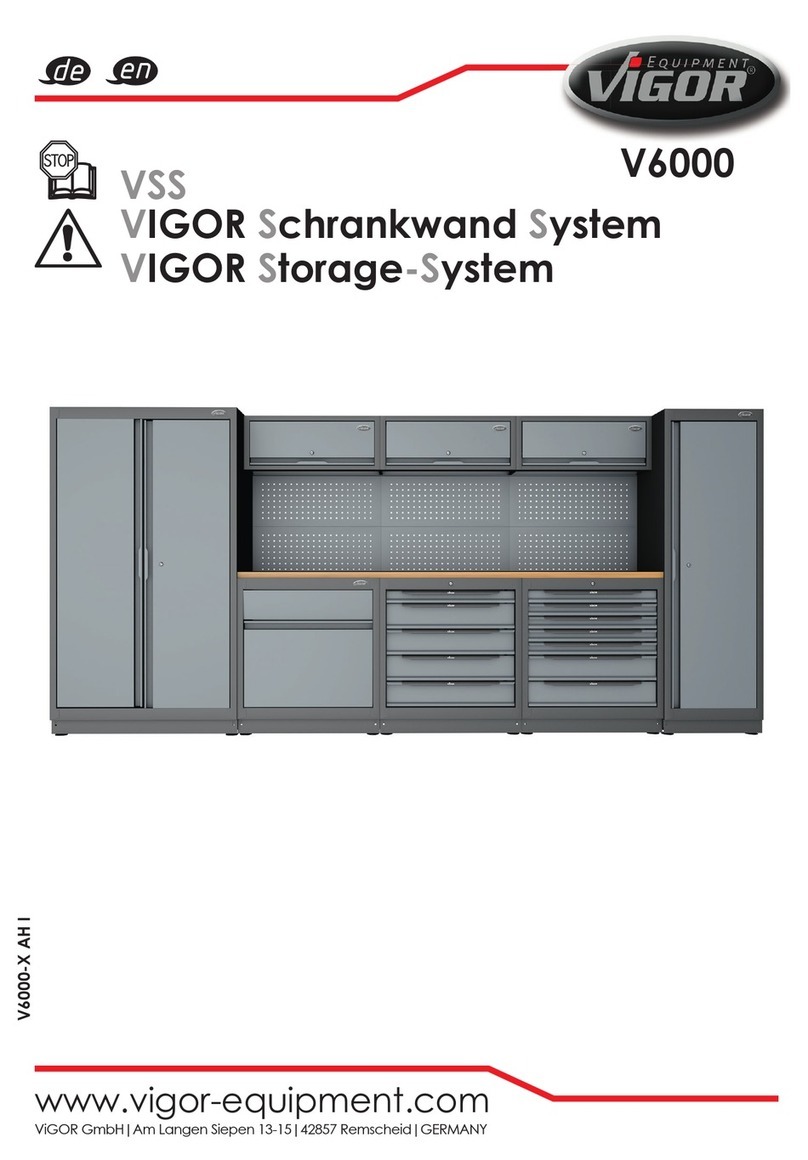
Vigor
Vigor VSS V6000 manual
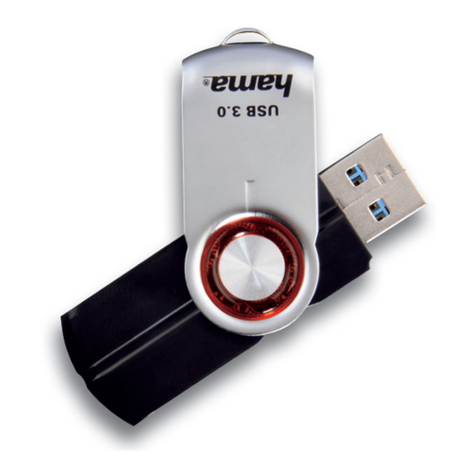
Hama
Hama Tenus FlashPen USB 3.0 Operating instruction

NetApp
NetApp StorageGRID Webscale SG5700 Series Hardware installation and maintenance guide

Wise
Wise CFexpress 4.0 CFX4-B Series quick start guide
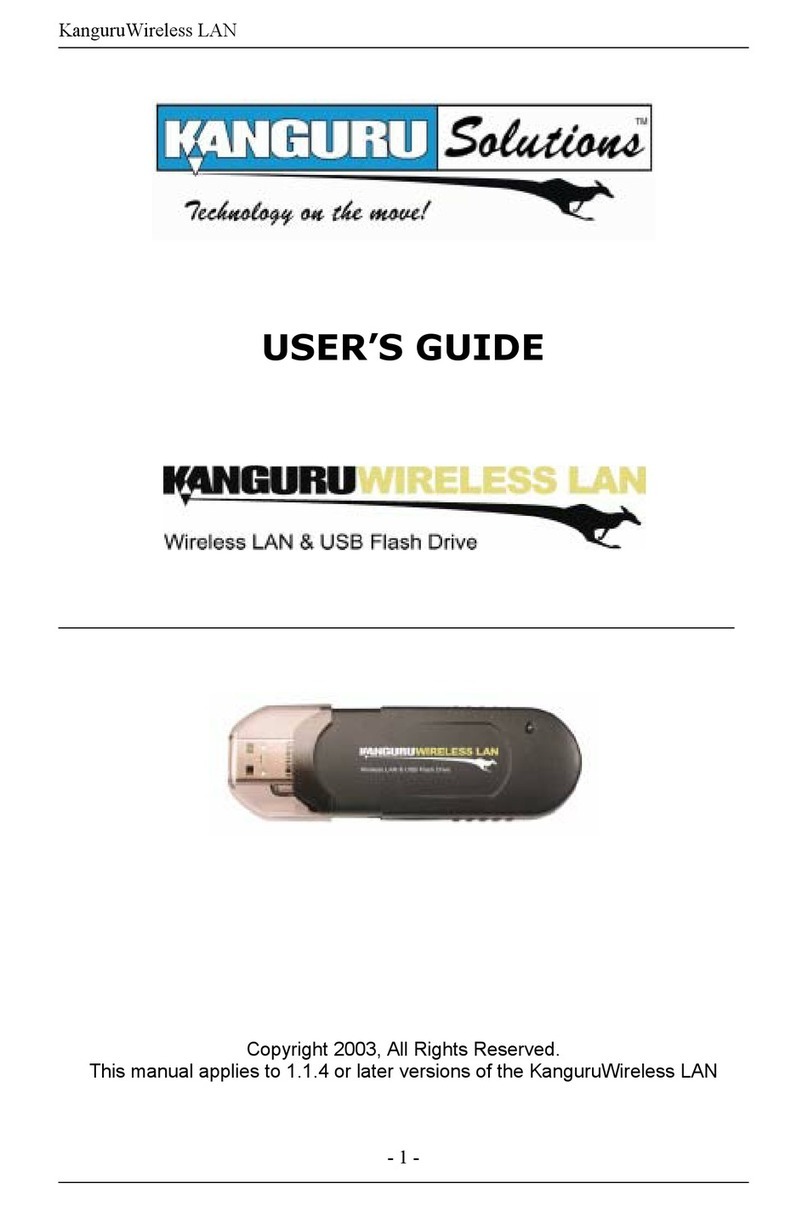
Kanguru
Kanguru Flash Drive Max user guide
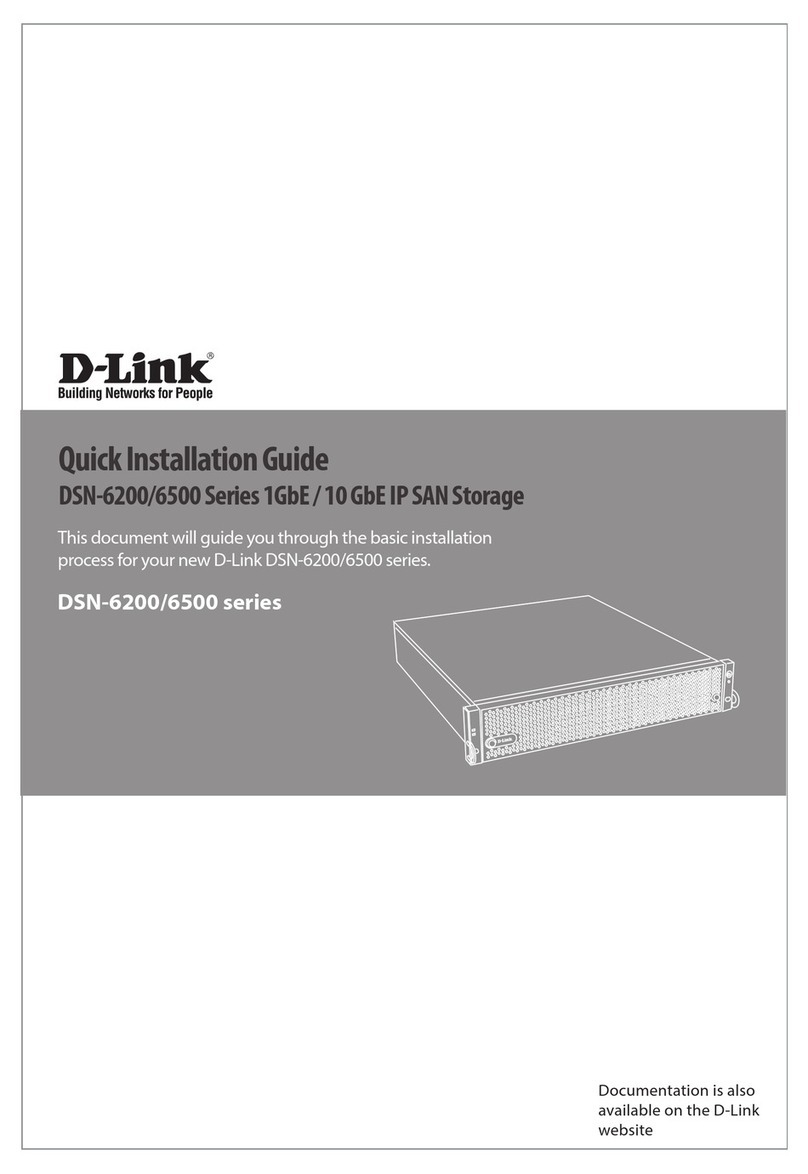
D-Link
D-Link DSN-6200 Quick installation guide

